 I just got back from a trip to London, where I stumbled upon the V&A Museum of Childhood. The Museum of Childhood?! How could I not go? I had a good time, despite wading through four different school groups in a relatively small space. Not the best museum I’ve ever been to, but they had some interesting stuff which I thought warranted a blog post.
I just got back from a trip to London, where I stumbled upon the V&A Museum of Childhood. The Museum of Childhood?! How could I not go? I had a good time, despite wading through four different school groups in a relatively small space. Not the best museum I’ve ever been to, but they had some interesting stuff which I thought warranted a blog post.
The entire first floor—half the museum—was essentially an exhibit on the history of the toy. While I wanted more information a lot of the time, the collection itself was fascinating. From a 13th Century BCE Egyptian doll to the newest Batman figures,

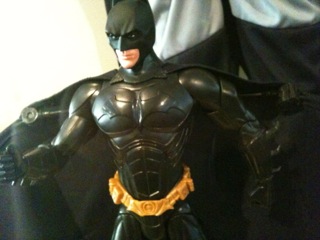
they pretty much had it all. There was an interesting selection of toys made from recycled materials in different cultures—most notably the semi-famous wire toys of several African nations.

There was an exhibit on how toys are manufactured, with some truly disquieting artifacts of doll-making.


There were some interesting anachronisms, like this 18th Century mahogony writing desk that no child over 2 could possibly fit at. But 2-year-olds can’t write! I was slightly baffled.
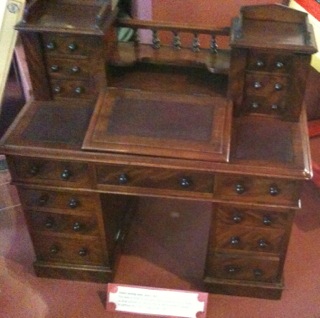
On the other hand, there was this fantastic model Viennese theater, made in 1825 by a father and daughter, with real working scenery flats. Amazing. It’s hard to tell from the photos, but the thing was a good three feet tall, hand constructed from wood.


Toys were grouped by category, so you could see interesting patterns across time and space—like in this collection of rocking horses from across history.



In that vein, it was amusing to see how little has changed over time in some ways. For instance, you know cars you pull back and then they roll forward on their own? The technology really hasn’t changed between the 1925 one and the “Batman Begins” model—just new packaging, really.
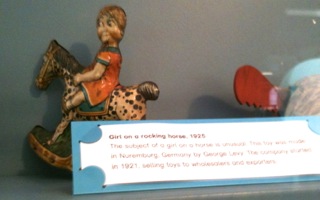

On the other new hand, the exhibit on the electric train mentioned that originally toy trains just ran on wall current, up to 250 volts. Hooray for modern safety standards! On the other hand, not all innovations are good. There was a Harry Potter “Hogwarts Express” train set that had a little mat you roll out that showed you where to lay each piece of track. What’s the fun in that? Make your own train route, darn it!
It was a little depressing to see the evolution of action figures, from the cartoony ones I remember from when I was a child:
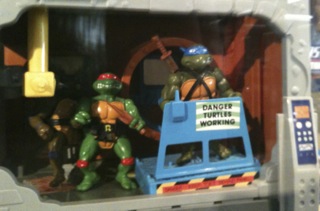
to modern ones, that clearly look exactly like the actors from the movies:

I want to play with Batman, not with Christian Bale! I think toys that are too realistic are hard to play with, because you can’t really put much imagination into them. There’s a set of plastic people, common in preschools these days, that represent all types of people—different ages, races, abilities, clothing, etc. But I hardly ever see kids play with them: they’re so realistic, they’re not fun! Whereas the wooden people, with just two little dots for eyes, are used all the time.
(Okay, in fairness, this one is how Adam West actually looked, but I think they just got lucky.)
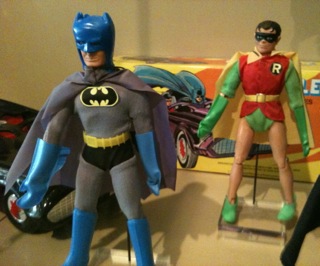
There were some other ones to be offended at, like Golly, a doll based on a 1890s-era series of books, but manufactured in the 1970s! I thought black-face had gone out of style by then, but apparently not entirely. Likewise, this racist chess set. I didn’t know chess could be racist, but apparently it can. (And, to the museum’s detriment, these examples were presented without comment, simply in the context of other dolls and games.)
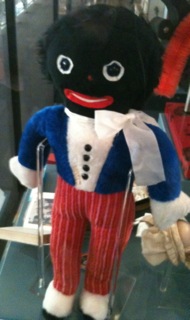

Some stuff reminded me of when I was a kid. I had the Spirograph! I had the superheroes checkers set!
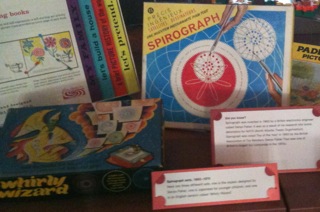

And some stuff just tickled me, like the 1920s dress-up tuxedo made by Colman’s Mustard, or the Beatles magnetic hair kit (now I know what to get my dad for Christmas…)


Upstairs at the museum were several more focused exhibits, including a remarkable one on the history of the dollhouse. Did you know the earliest dollhouses weren’t, strictly speaking, for play? They were intended as teaching tools, so that young girls could learn how to run a household. A lot of the old dollhouses were as tall as I was, and filled with stuff we would never give to children today—tiny choking hazards made of porcelain and crystal. Most of my photos didn’t come out in the dim light there, but this one, from a dollhouse made in 1673, was pretty cool.

The best exhibit of the museum was “Modern British Childhood, 1948–2012.” Those years were chosen as benchmarks for looking at how much has changed for children between the two times Britain has hosted the Olympics. And really, a huge amount has changed. They go decade by decade and look at changes due to the end of WW2, changing economics and family structure, culture and values, education policy… A really smart exhibit—not too much depth, but really painted a nice portrait of what’s changed.
The exhibit also included some writing about the present state of children’s play, which I thought was really well put (though poorly punctuated), and which I here excerpt:
“PLAY: Outdoor play has continued to decrease in recent years and adult supervision has become the norm. Play has become more structured. Even in gardens [or backyards], play often involves equipment, whether a climbing frame or a scooter, rather than relying simply on children’s imagination. Ironically, most parents would like their children to enjoy the freedoms they recall from their own childhoods and to spend more time outdoors. But they are anxious about risk. Indoor play has come to dominate. The explosion in technology has provided computer games, mobile phones and social networking. Through play, technology can expand the horizons of creativity and the imagination. But these opportunities are balanced by risks. Technology may also isolate children, from one another and from their parents.
“ENTERTAINMENT: Until recently, play was active, involved other children, and mostly took place outdoors. Entertainment was more passive, less about other children and took place indoors such as watching television, cinema or reading. Now, distinctions between play and entertainment are blurred. As outdoor play has decreased, so indoor play has expanded and become dominated by technology. A child can read a book, then see the film and play with related character figures and computer games … A 1999 study found that [British] children spent an average of 5 hours each day in front of a screen … Children are no longer able or allowed to be bored or unsupervised. As the focus on our children and childhood has sharpened, so, perhaps boundaries and possibilities have lessened.”
I also saw this wonderful quotation that I wasn’t familiar with:
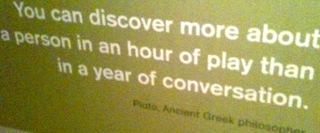
Finally, there was this lovely mural, painted by Dan Jones in 2004, of children’s playground games from around the world.




So! A good time at the museum—and like most London museums, it’s free! So if you happen to be passing by, give it a half a day.
The National Museum of Play in Rochester, New York is well worth a visit if you’re in that area of the country. Started as a collection of miniatures from the private collection of Margaret Woodbury Strong, the museum now has an extensive interactive play section, as well as wonderful archives and a research wing dedicated to the study of Play from a multidisciplinary perspective. Can’t wait to go back again!